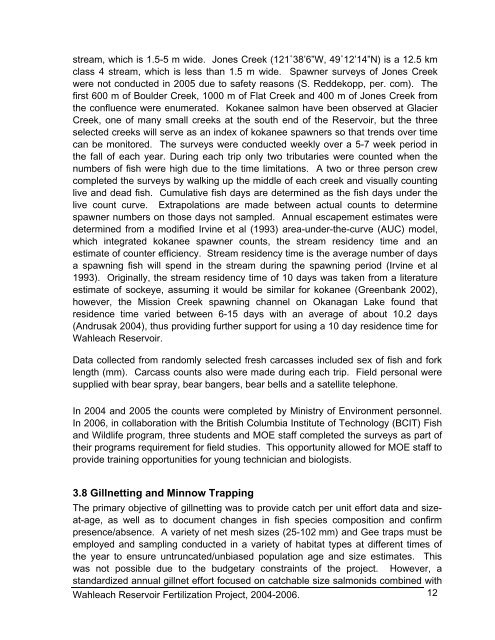Wahleach Project Water Use Plan Wahleach Reservoir ... - BC Hydro
Wahleach Project Water Use Plan Wahleach Reservoir ... - BC Hydro
Wahleach Project Water Use Plan Wahleach Reservoir ... - BC Hydro
Create successful ePaper yourself
Turn your PDF publications into a flip-book with our unique Google optimized e-Paper software.
stream, which is 1.5-5 m wide. Jones Creek (121˚38’6”W, 49˚12’14”N) is a 12.5 km<br />
class 4 stream, which is less than 1.5 m wide. Spawner surveys of Jones Creek<br />
were not conducted in 2005 due to safety reasons (S. Reddekopp, per. com). The<br />
first 600 m of Boulder Creek, 1000 m of Flat Creek and 400 m of Jones Creek from<br />
the confluence were enumerated. Kokanee salmon have been observed at Glacier<br />
Creek, one of many small creeks at the south end of the <strong>Reservoir</strong>, but the three<br />
selected creeks will serve as an index of kokanee spawners so that trends over time<br />
can be monitored. The surveys were conducted weekly over a 5-7 week period in<br />
the fall of each year. During each trip only two tributaries were counted when the<br />
numbers of fish were high due to the time limitations. A two or three person crew<br />
completed the surveys by walking up the middle of each creek and visually counting<br />
live and dead fish. Cumulative fish days are determined as the fish days under the<br />
live count curve. Extrapolations are made between actual counts to determine<br />
spawner numbers on those days not sampled. Annual escapement estimates were<br />
determined from a modified Irvine et al (1993) area-under-the-curve (AUC) model,<br />
which integrated kokanee spawner counts, the stream residency time and an<br />
estimate of counter efficiency. Stream residency time is the average number of days<br />
a spawning fish will spend in the stream during the spawning period (Irvine et al<br />
1993). Originally, the stream residency time of 10 days was taken from a literature<br />
estimate of sockeye, assuming it would be similar for kokanee (Greenbank 2002),<br />
however, the Mission Creek spawning channel on Okanagan Lake found that<br />
residence time varied between 6-15 days with an average of about 10.2 days<br />
(Andrusak 2004), thus providing further support for using a 10 day residence time for<br />
<strong>Wahleach</strong> <strong>Reservoir</strong>.<br />
Data collected from randomly selected fresh carcasses included sex of fish and fork<br />
length (mm). Carcass counts also were made during each trip. Field personal were<br />
supplied with bear spray, bear bangers, bear bells and a satellite telephone.<br />
In 2004 and 2005 the counts were completed by Ministry of Environment personnel.<br />
In 2006, in collaboration with the British Columbia Institute of Technology (<strong>BC</strong>IT) Fish<br />
and Wildlife program, three students and MOE staff completed the surveys as part of<br />
their programs requirement for field studies. This opportunity allowed for MOE staff to<br />
provide training opportunities for young technician and biologists.<br />
3.8 Gillnetting and Minnow Trapping<br />
The primary objective of gillnetting was to provide catch per unit effort data and sizeat-age,<br />
as well as to document changes in fish species composition and confirm<br />
presence/absence. A variety of net mesh sizes (25-102 mm) and Gee traps must be<br />
employed and sampling conducted in a variety of habitat types at different times of<br />
the year to ensure untruncated/unbiased population age and size estimates. This<br />
was not possible due to the budgetary constraints of the project. However, a<br />
standardized annual gillnet effort focused on catchable size salmonids combined with<br />
<strong>Wahleach</strong> <strong>Reservoir</strong> Fertilization <strong>Project</strong>, 2004-2006.<br />
12
















